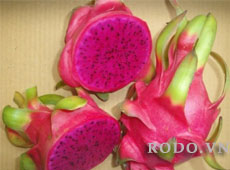Dragon fruits are widely consumed in Asian countries like Taiwan, Vietnam, Thailand, the Philippines, Sri Lanka and Malaysia. They are also popular in Mexico and in central and South America. The other name for this fruit is Pitaya or Pitahaya. The fruit is obtained from several cactus species, but the most important is the one obtained from the genus Hylocereus (sweet pitayas). Hylocereus or sweet pitayas come with a creamy pulp and a delicate aroma.
Nutrition Facts
100 g of dragon fruit contains:
Fiber 0.9 g
Calcium 8.8 g
Fat 0.61 g
Carotene 0.012 g
Niacin 0.430 mg
Phosphorus 36.1 mg
Ascorbic Acid 9.0 mg
Protein 0.229 g
Water 83.0 g
Ashes 0.68 g
Iron 0.65 mg
Riboflavin 0.045 mg
Consumption of 1.5 oz of a 'dried' fruit, equates to almost eating a full pound of the 'fresh' fruit. It is beneficial as it contains all necessary and important micro nutrients, fiber and vitamin C.
Calories
The fruit is low in calories. 100 gm of 1 tropical dragon fruit contains about 60 calories. So it can be included in weight loss diets.
Health Benefits
Dragon fruits are rich in antioxidants. They help prevent the formation of carcinogenic free-radicals.
They (especially red-skinned pitayas) are packed with vitamin C. Vitamin C ensures fast healing of bruises and cuts and helps improve the function of the immune system.
Vitamin B2 acts as a multivitamin and helps improve your appetite.
Vitamin B1 plays an important role in the production of energy as it promotes metabolism of carbohydrates.
Vitamin B3 lowers bad cholesterol level and enhances the appearance of the skin by making it moist and smooth.The seeds of the fruit contain high polyunsaturated fatty acids.
The fruits help get rid of heavy metal toxins from the body.
They help lower cholesterol and high blood pressure.
They work great for asthma and cough.
Carotene obtained from the fruits helps maintain and improve the health of the eyes.
Proteins from the fruit help enhance metabolic processes in the body.
The fruit serves as a food substitute for rice, especially for the diabetics.
It can be used as cosmetic and health material, as it improves eyesight and prevents hypertension.
It is a good material for beverages, delicious vegetable dishes, as it comes with high nutrition, low heat and vitamin C.
The fruits are rich in minerals, especially calcium and phosphorus. Calcium reinforces bones and helps in the formation of healthy teeth. Phosphorus aids in tissue formation.
These fruits are low in calories and high in fiber. They help avoid constipation by acting as natural laxatives. They help improve the overall digestive health of a person. Fiber from the fruits enhances the process of digestion and helps control accumulation of fats.
Regular consumption of fresh or dried dragon fruit helps maintain the health. The fruit comes in three varieties - red skin with red flesh (widely considered to be the best-tasting), red skin with white flesh and yellow skin with white flesh. Dragon fruit plant has strong roots and is good at water conserving. It can be cultivated easily. It is also good at heat and drought resisting. So growing these fruits is quite easy and economical. The fruits have a leathery, leafy red skin. One dragon fruit can weigh from 150-600 grams. It can be described as mildly sweet and is best served cold. To eat it, you should simply cut it in half, and then, scoop out the flesh with a spoon. The skin may not be eaten. The little black seeds can be eaten along with the flesh, just like a kiwi fruit. The middle of the fruit is the sweetest part of the fruit.
I hope the information about dragon fruit nutrition facts helps you make way for the new, aptly named super fruit, the dragon fruit! This fruit is the latest entrant to the world of super fruits.
By Leena Palande at buzzle.com
Read more at Buzzle: http://www.buzzle.com/articles/dragon-fruit-nutrition-facts.html





